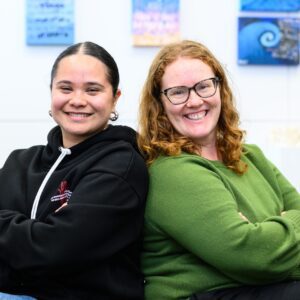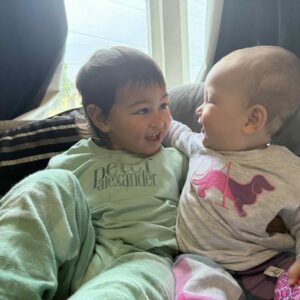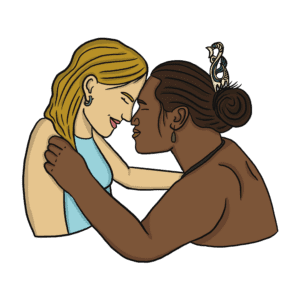



Te reo revitalisation is personal for Māori
One of my earliest memories of te reo Māori is of being in a warm dark room at night, listening to my Nan and Koro quietly speaking Māori while I lay on a mattress on the floor next to their bed. Having been brought up speaking English first, I didn’t understand their words then, but I have no doubt that these experiences helped form my deep love of, and commitment to, my language and culture. As a Māori researcher of Tūhoe and Ngāti Awa descent, the work to revitalise our reo is personal to me, it is personal to Māori, and it is personal to future generations of Māori.
Te reo Māori is the latest cool kid on the block
I clearly remember when, with a few exceptions, generally only Māori were interested in reo Māori revitalisation. Now, we are seeing the fruits of generations of hard work by reo Māori activists and advocates, many of whom were recently honoured and remembered at Ngā Kākā Kura o te Reo 2022. Te reo Māori is being valued and used not only among Māori but becoming more so among non-Māori too. The annual celebration of te reo Māori in September has been gathering momentum in recent years. We’ve seen famous artists – Māori and non-Māori – releasing songs in te reo Māori for the first time, and phrases like “e whai ake nei” rolling off the tongues of non-Māori newsreaders. Our language is in the non-Māori public eye so to speak and for now, it’s getting a lot of attention. The positive interest and enthusiasm for our reo from many non-Māori is at once both a reason to celebrate, because we are more likely to have a positive linguistic environment for our language to thrive in, but also to think critically about the new challenges ahead.
Over the weeks of Mahuru Māori and Te Wiki o te Reo Māori the commentaries and passionate debates by Māori about who is using te reo Māori, their motivations for using it, and who is missing out overran my social media feed. As Māori, we are grappling with what it means and feels like to share hard-fought space for our reo, where we may soon be outnumbered by non-Māori and their aspirations for the reo.
Education will drive change
Our nation is on the cusp of a growth spurt in our understanding of identity, language and culture. Strong direction from government about reo Māori provision in schools, new curriculum content for Aotearoa New Zealand’s Histories and Te Takanga o te Wā that kura and schools are expected to begin implementing from 2023, and a New Zealand Curriculum refresh that aims to be bicultural and inclusive, are priming the education system for change. These changes will impact how people see their place in this country and their relationship to te reo Māori, the indigenous language of Aotearoa. Māori and non-Māori, learners, teachers, whānau and communities will be affected in different ways.
What are the roles of Māori and non-Māori in revitalising the reo?
As this sea change occurs in the education system, I am reflecting on what it means for researchers who are working to support reo Māori revitalisation through education. I work at NZCER – a research organisation that has contributed to reo Māori revitalisation research for many years, and has recently made a commitment to becoming a bilingual organisation. As a group we are beginning to have hard and critical conversations about what our roles as Māori and non-Māori researchers in reo revitalisation will be. Sharing the language revitalisation space with increasing numbers of non-Māori brings challenges and tensions that must be worked through so that we do not lose sight of who this work is most important to – Māori.
Reo Māori revitalisation has to benefit Māori first
Māori have experienced the power of the education system being used against us and our reo. The assimilationist agenda that actively deterred the use of te reo Māori in schools from the early to late 1900s is a prime example. Now the focus of the English medium education system, which has been a very effective tool of assimilation and colonisation, is changing to support reo Māori revitalisation. The interest in te reo Māori amongst non-Māori is snowballing, a juggernaut that could easily swallow up resources and people before it. How do we make best use of this interest and support, while making sure we are not submerged in another wave of colonisation, this time of our language, however benevolent and well intentioned? As recent research into reo Māori in schools shows, we need to prioritise resources for Māori – especially Māori speakers of Māori who are the best resources – to ensure that te reo Maori will survive and flourish.
What is our responsibility as researchers?
As researchers, we have to prioritise and hold space for Māori. While everyone is welcome to learn the reo and enjoy the many benefits that come from understanding and using multiple languages, it remains crystal clear to me that this work must benefit Māori first. In the flurry of activity and enthusiasm from non-Māori to learn our language, we must ensure that Māori, for whom the reo is most important, are not forgotten.
It is important to have conversations about what holding space for Māori does or could look like in language focussed projects that are kaupapa Māori, Māori-led, Māori-centred or Māori-informed, and to be careful that we don’t try to artificially separate the reo from tikanga and identity.
It means encouraging non-Māori colleagues to have critical conversations about who benefits from the work they want to do in language revitalisation. To understand what it means to be a good ally, to strive for social justice and equity. It means not only focussing inwards on aspirations for the reo as an individual but to look outwards and embrace collective aspirations for Māori, understanding that Māori must lead the way in saying what those aspirations are.
I’ll admit that change on the scale that it is occurring makes me uneasy. But I also know that I want to react to it with positivity and aroha. For me, that means staying true to the purpose of the reo Māori revitalisation movement, to support whānau Māori first and always to pass the language on to our mokopuna. Ko tōku reo tōku ohooho, ko tōku reo tōku māpihi maurea.
Nicola Bright is of Tūhoe and Ngāti Awa descent. She is a Kairangahau Matua (Senior Researcher) in the Te Wāhanga team at NZCER. Her primary – and lifelong – interest is in contributing to the revitalisation of te reo Māori. She is also interested in how people’s ideas and understandings about identity in Aotearoa may change over time as more mātauranga Māori is included in the New Zealand curriculum through subjects such as te reo Māori, Aotearoa New Zealand’s histories and Te Ao Haka.
An earlier version of this article was originally published on Ipu Kererū, the blog of the New Zealand Association for Research in Education (NZARE).
Related Posts

Learning a language isn’t easy, and with cuts to funding there’s even less support for educators to take up the challenge of learning te reo Māori. Meriana Johnsen meets the kaiako at Tawa Intermediate who are going above and beyond to bring more te reo into the classroom.

Jasmine Taankink (Ngā Mahanga-a-Tairi) is a second language speaker of te reo Māori committed to the intergenerational transmission of te reo in her whānau and community. She shares with us her hopes for her three moko.

Two years since it was made compulsory in schools, Heeni Collins (Ngāti Raukawa, Ngāti Haumia) finds out about the positive impacts of Aotearoa New Zealand’s histories curriculum on teachers and students, and the barriers they still face to implementing it.

In 2022, Ngāti Rēhia began a partnership with local schools in Kerikeri to incorporate its pūrākau and mātauranga into Aotearoa New Zealand’s histories curriculum. Ako Zoomed in to Kerikeri to hear from Riverview Primary School teacher Samantha Roessler and Ngāti Rēhia Matua Taua Kemp about the significance of this collaboration for their students and community.